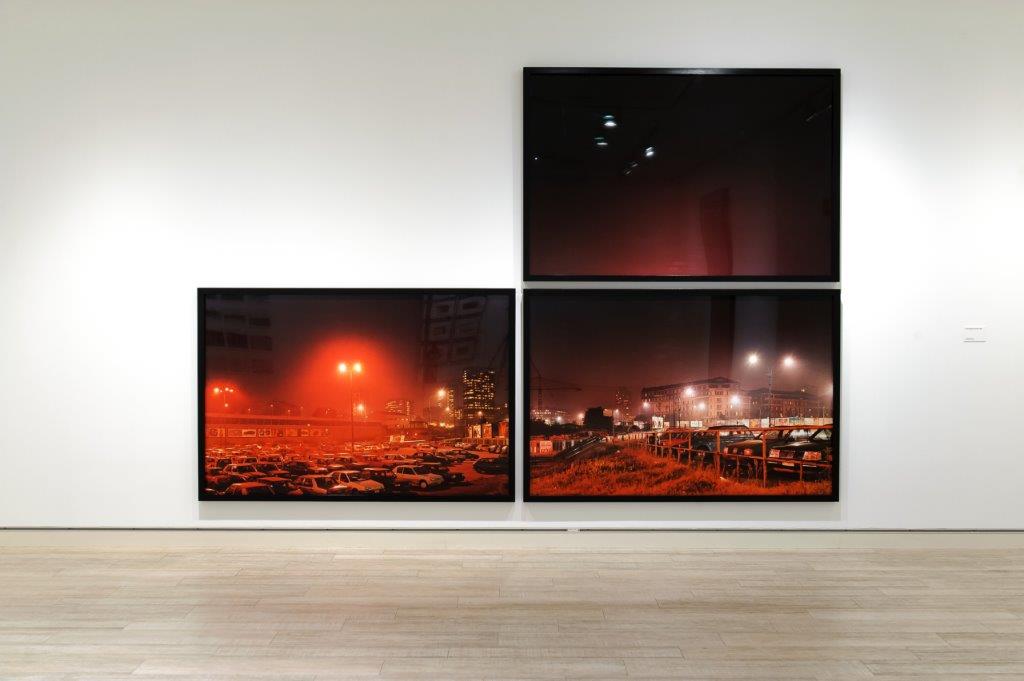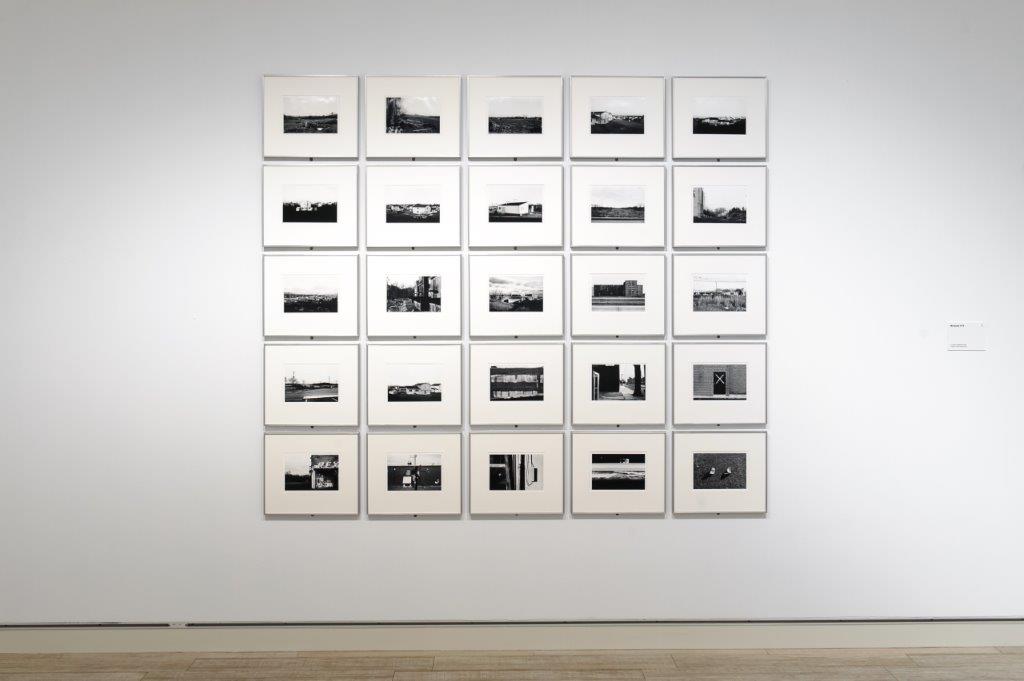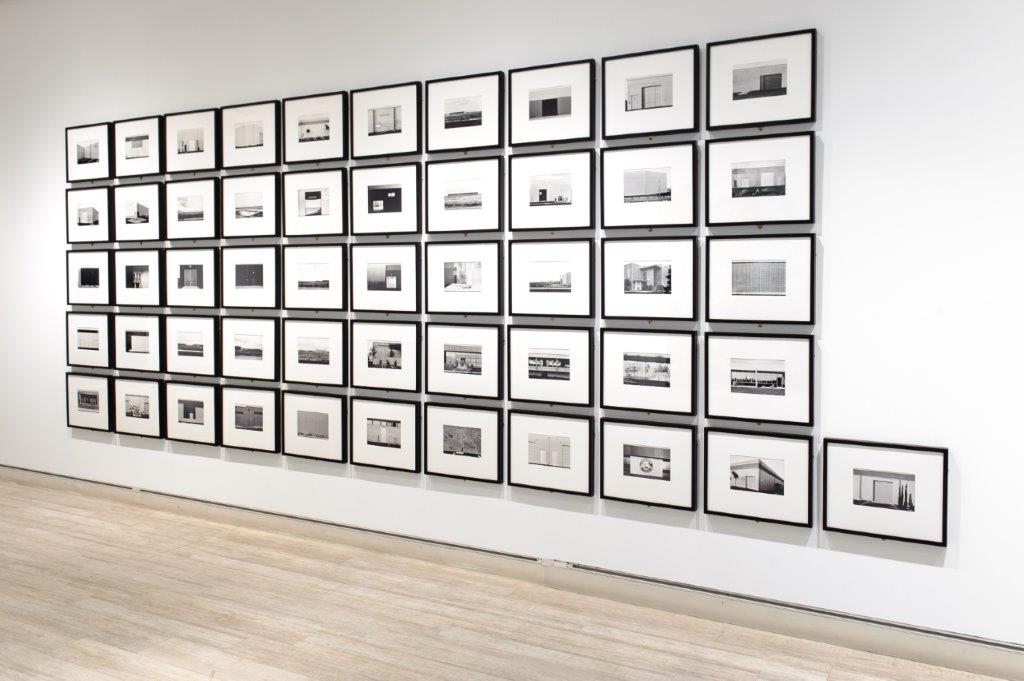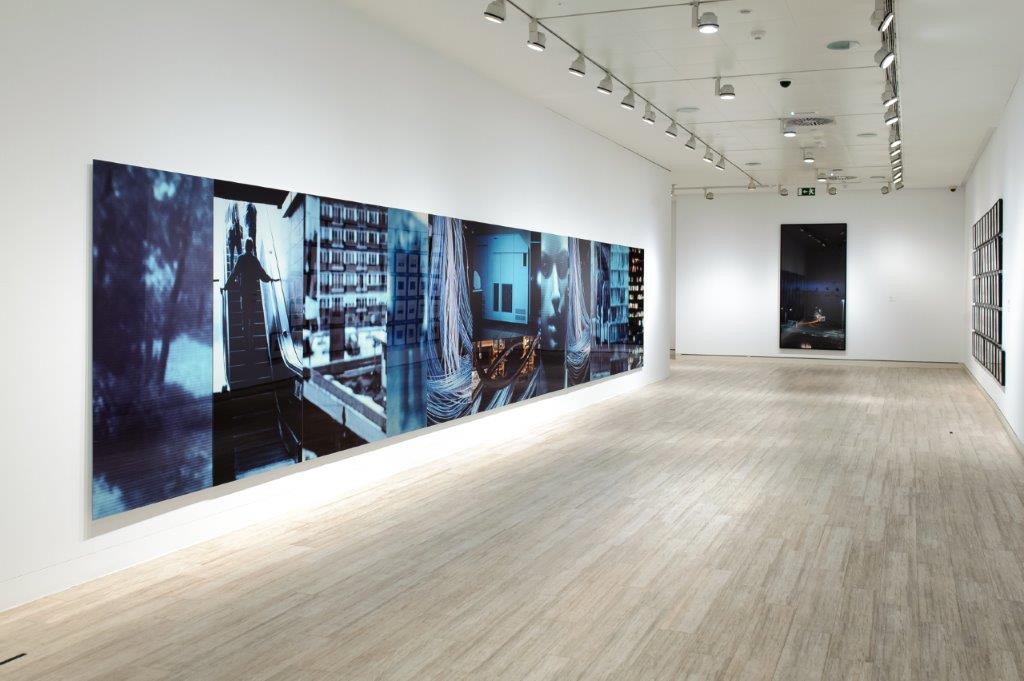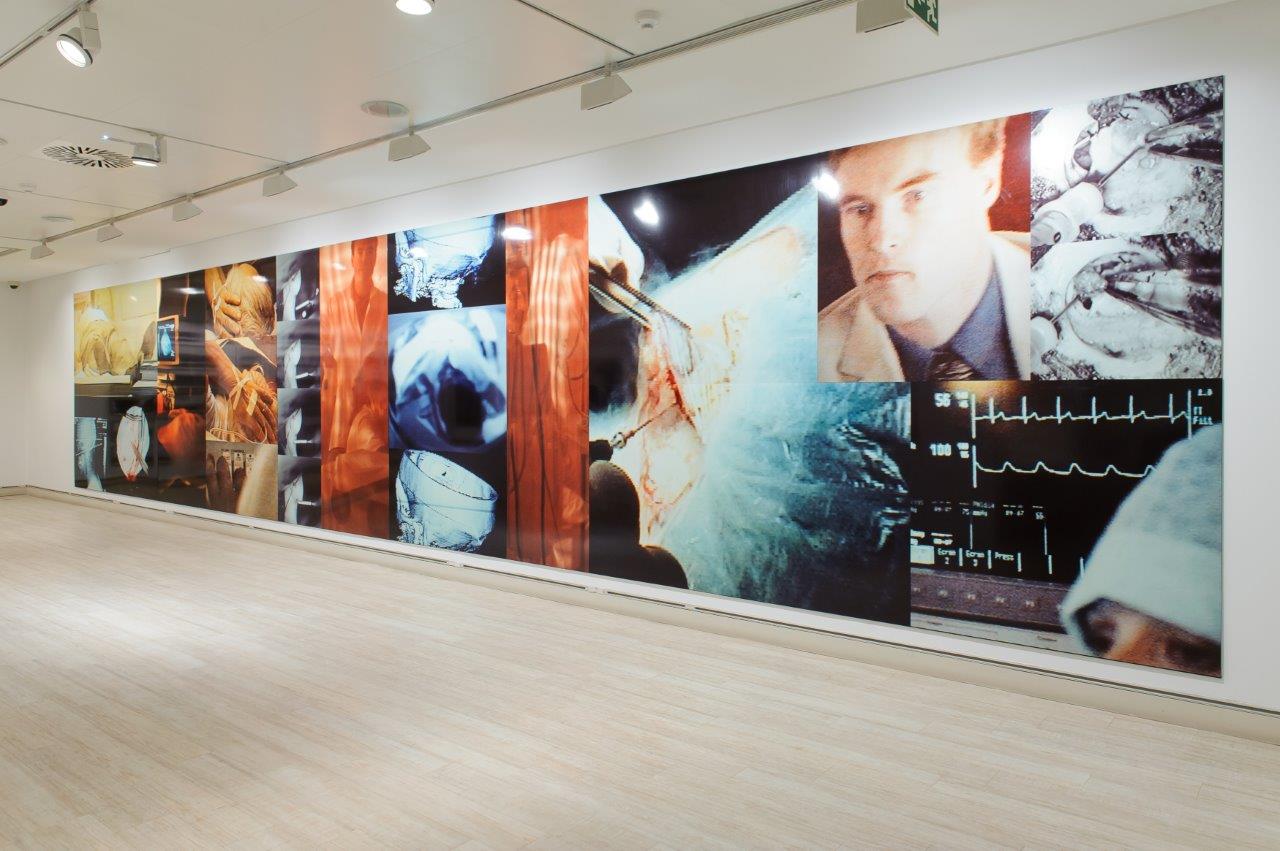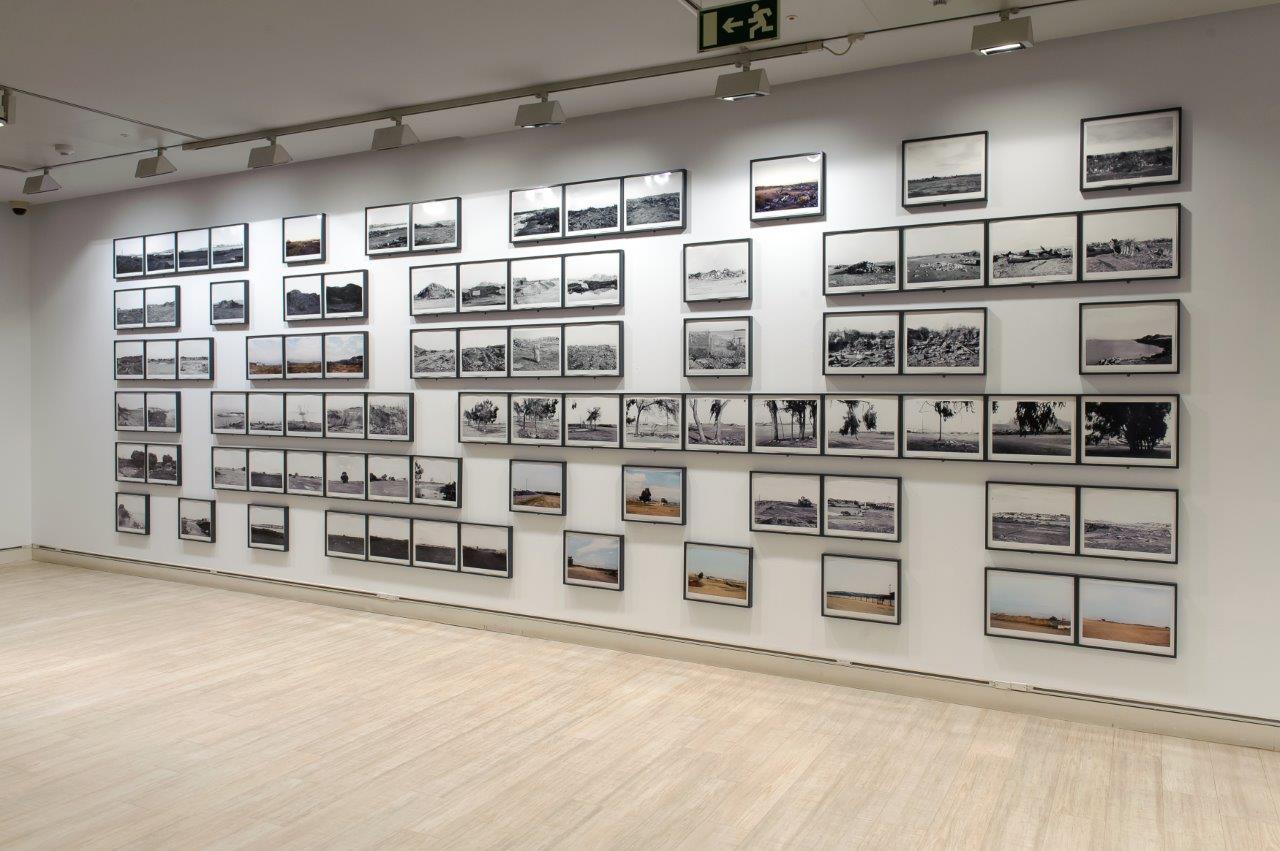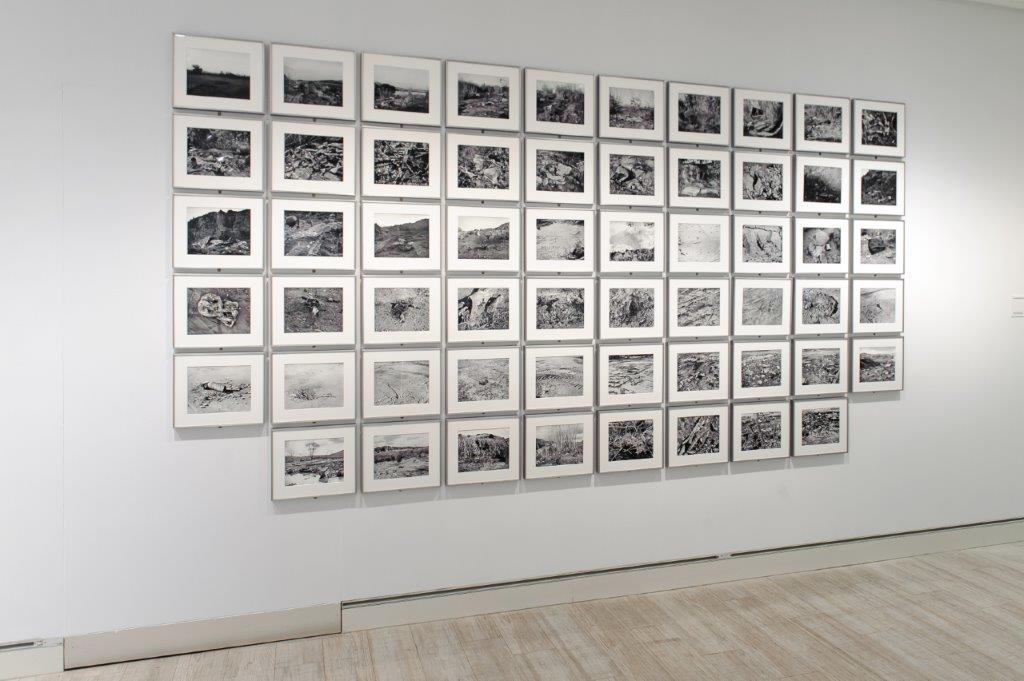The work of Lewis Baltz (Newport Beach, California, 1945 - Paris, 2014) has traditionally been related to the generation of photographers associated with the exhibition New Topographies, which questioned the idea of landscape as a beautiful, existential and almost sacred image and rather presented it as a reality and as the result of man’s almost invariably negative actions. Baltz used photography as a means of expression and a tool of research and knowledge, very much in line with the philosophy and art of the 1960s and 1970s. This exhibition presents the work of Lewis Baltz in its totality, from his earliest series of small-format, black and white photographs taken in the 1960s to his colour photography and his exploration of new artistic languages from 1989 onwards.
The influence of film on Baltz’s work explains why most of his output is organised as series, although devoid of a necessarily narrative structure or composition. The presentation of these different series in grid form faithfully reflects the way the artist conceived them and contributes to their reading in a fundamental way.
The exhibition’s structure establishes a dialogue between the groups of early works and late works, following Baltz’s own practice initiated in 1993. In this exhibition guide, however, the groups are presented in a chronological ordering.
Ground Floor
From the outset of his career in the 1960s and until the late 1980s, Baltz focused on a study of the effects of man’s actions on the landscape. This process of research led him to understand landscape as an occupied, remodelled, constructed space and to present these constructions as a mute, almost faceless architecture. For the artist, the landscape became “landscape as real estate”, in which the countryside and the city are one and the same thing in economic terms. In the manner of a topographer, Baltz measured and charted it in his photographs.
The Prototype Works (1967-1976)
Baltz produced many of the photographs that he would ultimately term “prototypes” during his years as a university student at the San Francisco Art Institute. They reflect an already developed interest in and commitment to American contemporary art.
These prototypes juxtapose two aspects. Firstly, they portray Californian architecture (often commercial buildings or small-scale industrial ones) in an absolutely frontal manner, with their windows and doors shut, derelict, and transmitting a sense of abandonment and decline, of a dead end and of melancholy. In contrast, Baltz’s images of cars, his snapshots of motel rooms and his street signs and neon signs produce a strikingly fresh and appealing effect, as if he were working with the dichotomy between the real and the symbolic world, between harsh reality and the world of aspirations, and as if the signage of the commercial world ricocheted off the mute walls of the constructed world.
Tract Houses (1969-1971)
Tract Houses shows a development of individual family houses in the process of construction next to a highway. Baltz narrowed the angle of view in order to show only the façades, windows and as yet unopened doors. His shots are almost always frontal: fragments of façades, windows and doors, which are so precise and tight that the dirty, rough and still unplastered walls of the houses appear to the viewer as a carpet of different materials. Two or three photographs use a sufficiently wide angle to show the houses not just as a symbol but as part of a tightly-packed property development squeezed in on itself.
Maryland (1976)
In this series Baltz looks at a group of houses, in some cases from a slightly elevated viewpoint, showing their location in relation to each other. He wanders around the development, focusing on the unfinished, strolling about, apparently unaccompanied, in early morning or evening light. The interaction between the sunny houses and the dark grass makes these residential zones seem alien, transforming them into an at times slightly disturbing setting with menacing, dark and deep shadows. Although we only discern his presence through the camera’s gaze, Baltz nonetheless seems notably present, “stalking” the location and exploring an unknown place. This series suggests a film project and in retrospect can be understood as preparatory to the large group of images entitled Park City.
Nevada (1977)
As Robert A. Sobieszek wrote: “In Nevada Baltz’s focus is no longer on the sterile architecture of an equally sterile late-century environment, but on an entropic terrain vague where what is built is merged with what is unbuilt, where “sprawl” and “blight” have become the picturesque norm, where the positions of observer and inhabitant have become confounded, and where past and present are intermingled.”
This series notably brings to mind the start of the French nouveau roman literary trend with its capturing of an event, a situation, a place or different realities from numerous different perspectives. For the first time this approach questioned the position of the autocratic creator who alone guides the camera, the action and the narrative.
The new Industrial Parks near Irvine, California (1974)
The new Industrial Parks near Irvine, California combines the approach of The Tract Houses with that of Maryland, mixing houses seen from close up with views of the landscape and the location of cube-like factories and industrial sheds. In contrast to the images in Tract Houses, almost all the buildings here are finished and ready to be viewed by potential buyers. The spectator is confronted with façades almost invariably photographed from the front and with buildings that, due to the chosen viewpoint, lose all their spatial content and become themselves an image - abstract, mute geometry - given that these façades reveal almost nothing about themselves, nor about what lies behind them or about their possible function. The series thus presents us with a money-saving modernity and with the minimalism deriving from the economising use of the banal, cubic form for the houses, only chosen because it was cheaper to build than any previously existing option.
Ronde de Nuit, see the back of the brochure*)
Generic Night Cities, see the back of the brochure*)
Rule without Exception, see the back of the brochure*)
Park City (1978-1980)
Park City represents both a turning-point in Baltz’s work and the culmination of his previous artistic concerns. In this series the artist focused on a large-scale construction project in the form of a dormitory city built on the contaminated site of an old silver mine, from which the promoter hoped to obtain extremely large profits. This is an extensive and precise project of visual research in which the artist initially documented the subject from the outside before moving step by step closer to this contemporary encampment, surrounding it and employing a pre-established grid to firstly photograph the storage areas, then an increasing number of specific sections and finally the houses themselves, the interiors of the “homes”, which gradually emerge as the inner promise of a housing development with aspirations to luxury.
Baltz surveys this entire property development in the manner of a topographer, annotating the position and orientation of each photograph. The tradition, the almost talismanic power, of the vast, open landscape thus encounters its exact opposite, which is nothing other than the strict market economy of property development aimed at financial profit.
Basement level -1
Continuous Fire Polar Circle (1986)
San Quentin Point (1981-1983)
Near Reno (1986-1987)
Candlestick Point (1987-1989)
Within Baltz’s early phase the four series San Quentin Point, Continuous Fire Polar Circle, Near Reno and Candlestick Point can be summarised as a great chant: the visible world collapses onto itself, losing the order and structure that give it form. In Continuous Fire Polar Circle we see how mounds of rubbish ceaselessly burn in what could be a Purgatory of the mass-consumption West. In Near Reno a sort of travelling through three or four photographs allows us to experience an entirely manmade nature. When they reach the plain the photographs focus almost entirely on decomposition and on active destruction, with the aggressive presence of tin cans, thrown-away tv sets, punctured metal cladding and even a dead sheep. The series concludes with extremely ambiguous images in which every length of hose and piece of cable insulation provokes mistrust, doubt and fear.
In San Quentin Point Baltz walks towards a rubbish tip on San Quentin Point on the San Francisco Bay and, in the manner of a detective, firstly photographs the terrain from outside it. Then, his viewfinder turned on the rubbish, he lowers his gaze and looks carefully and precisely at what is happening within that square of vision on the ground. This group of works transmits a heavily-charged mood full of tension and ambivalence, with photographs that precisely and crisply capture what has happened, in the manner of recording an important archaeological site. Meanwhile the accumulation of rubbish that he includes in the shot randomly spills out at its edges. Baltz’s series, which makes use of visual irony and sarcasm, thus becomes a symbol of a society in a process of collapse and implosion.
Candlestick Point, the last series from this initial phase, is by contrast the most radical from a graphic viewpoint. The arrangement of the photographs on the wall constructs a system in which Baltz consciously introduces gaps. Candlestick Point clearly comes close to the electronic generation of images, even when still created using traditional means. As we move through its contemplation, we start to doubt if there really is a man, a creator, behind the work, or whether it is actually the result of the images represented on the monitors of the security camera. No particular photograph stands out and their graphic properties are kept within very narrow limits in which, every now and then, Baltz’s earliest colour photographs make a seemingly unintentional appearance. This is the culmination of the representation of an entropic landscape in which Baltz withdraws as the creative figure, allowing his camera to take charge. The result is this landscape, a radically alien one for Baltz. It is his farewell to a United States that alarms and profoundly saddens him. We witness Baltz’s great farewell to photography as he always understood it.
+++++
The year 1989 marked a surprising change in Baltz’s approach to photography, and his works reveal a completely transformed artist. His fundamental hypothesis – that urban development (and all contemporary life) is the objectivation of power and that power is ideology per se – remains present but now with an additional concept: that the rest is pure spectacle. Baltz soon realised that we are witnessing the start of a new media-based era in which social events are exclusively brought about by the media and reflected by them. The media thus produce a hyper-reality, with the consequence that it is impossible to distinguish between authentic events and simulated ones.
In this second phase Baltz worked with colour photography and with different sizes (sometimes extremely large-format images) and also began to include video and found photographs in his work.
Generic Night Cities (1989-2000)
Rule without Exception (1988)
Piazza Sigmund Freud (1989)
In these works we see nocturnal urban landscapes in colour, entirely devoid of any daytime light that could produce a natural, clear and hierarchical ordering and with numerous artificial lights, both stationary and in movement, that attract and direct our gaze. Baltz thus presents the city as a parking lot or a driving lane, “stop and go”, like a strident urban laboratory. These varied images are delicate, flat and multi-coloured, like dashboards, while the cities represented convey the sensation of being open electrical circuits: a mechanism of desire and power activated by the motor of neo-liberal exploitation and as such devoid of any perspective or future.
Sites of Technology (1989-1991)
For this project Baltz documented in colour a subject he had initiated in black and white in The new Industrial Parks near Irvine: spaces, buildings, research centres, industrial installations and security systems lose their individuality and cease to be recognisable, now presenting a totally anonymous appearance. As artist Walead Beshty has said: “the topographical cartography of the capitalist landscape that Baltz produced throughout his career was what led him in this series to the headquarters of Cray Supercomputers, Mitsubishi, the CERN and France Télécom, where the information networks of financial exchange were being developed […]. This was the emerging landscape of financial capitalism.”
Ronde de Nuit (1992-1995)
Docile Bodies (1992-1995)
In Power Trilogy, comprising Ronde de Nuit, Docile Bodies and The Politics of Bacteria, Baltz explores the theme of surveillance, control and research. This exhibition includes the first two works. When creating them Baltz almost invariably worked with images from his own archive, which he selected, manipulated and enlarged in order to achieve the final work. The result is a rhythmical arrangement of photographs into large blocks, mounted to form wall fragments. Monumental in size, the three series do not function as mere photographs hung on the wall: rather they are the wall. This is the culmination of what Baltz initiated in his early work: the confluence of the plane of the photograph and of the support with the plane of the wall, the coincidence of image and world, of world and image.
In Ronde de Nuit we emerge from a type of fairy-tale world in order to plunge into the underworld, finally emerging from the darkness in a modern sea of stars, the dazzling sea of lights of a large city, with Manhattan as the absolute firmament. Extracts from surveillance videos from a police station are combined with photographs of cables, hoses and a large computer.
In Docile Bodies images of neurosurgery allow us to penetrate the skin and the appearance of things and enter the interior of the body and its mechanism. We thus have a completely new form of submission and a new form of power: the docility of the body in the face of knowledge organised as force and power, the intrusion into the inviolable, into the intimacy of the body.
The Deaths in Newport (1988-1995)
The Deaths in Newport resulted in the unexpected emergence of Baltz as a narrator. Before this project took shape as an exhibition, a book, and soon afterwards a CD-ROM (in different and changing formats), Baltz narrated the shocking story of a double murder that took place in southern California in the 1950s. A yacht blew up, a couple were killed and their daughter and son-in-law accused of the crime. The case attracted enormous media attention at the time. Baltz tells the story, illustrated with numerous archive photographs, in a direct, laconic manner as if he were the son of the original narrator. A visual artist narrating a story from his childhood, with his father (one of the principal witnesses) as a personal reference, guiding us through the social drama of post-war America on the Californian coast.
End to End (2000)
Moving along the famous Via Emilia, in the video End to End Baltz makes use of a mobile video camera to narrate the political and economic history of Emilia-Romagna after World War II. Solely directed at one side of the road, the camera shows everyday life as it happens while the voice and text reveal the structures of this region of Italy.
Venezia-Marghera (2000/2013)
Finally, for the project Venezia-Marghera Baltz took as his theme the impossible coexistence of Venice and Marghera, the legacy of universal culture and the Moloch of the refineries. Here Baltz offers us his final vision of man-altered landscape: the industrialised town of Marghera located near Venice, with the latter in turn becoming the victim of mass tourism.

